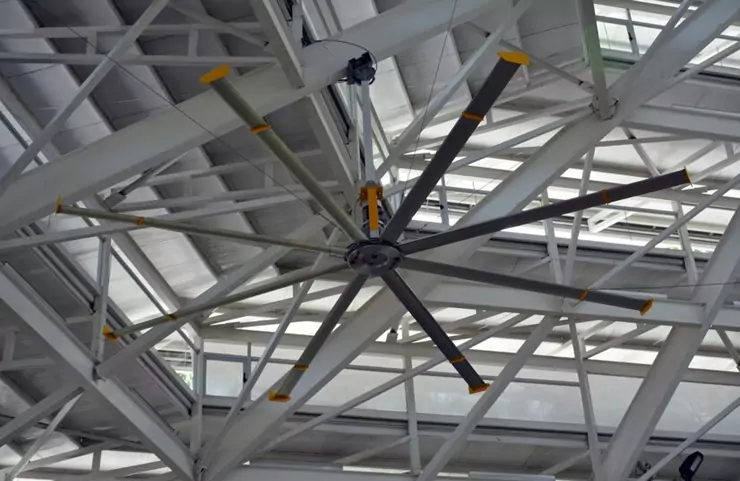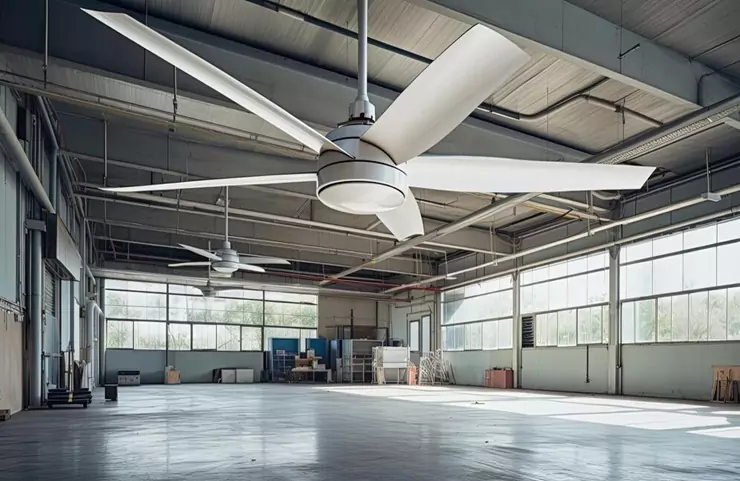HVLS Fan For Factory
Introduction
Factory environments are challenging spaces that demand efficient ventilation solutions to ensure productivity, safety, and comfort. High-Volume, Low-Speed (HVLS) fans have emerged as the ultimate solution to these challenges, revolutionizing airflow management across industries like industrial, commercial, agricultural, healthcare facilities, and even government and public sectors. Whether you’re running a manufacturing unit, warehouse, or agricultural facility, understanding the benefits and applications of HVLS fans can transform your operations.
What is an HVLS Fan and How Does It Work?
- Definition of HVLS Fans: HVLS stands for High-Volume, Low-Speed—large industrial ceiling fans that move massive amounts of air at low speeds. These fans are engineered to create a more even distribution of airflow compared to traditional ventilation systems.
- How They Work: HVLS fans work by generating large air columns that move horizontally across spaces, creating a cooling effect through evaporation and enhanced air circulation. The low-speed operation ensures minimized energy consumption while maintaining optimal performance.
Why Choose HVLS Fans for Factories?
- Energy Efficiency: Compared to traditional ventilation systems, HVLS fans consume significantly less power, resulting in lower utility costs.
- Cost Savings: Investing in HVLS fans offers long-term savings on energy bills, maintenance costs, and even HVAC system wear-and-tear.
- Improved Worker Productivity: Better ventilation leads to improved comfort, which boosts morale and productivity among workers.
- Environmental Sustainability: HVLS fans contribute to reducing carbon footprints, aligning with global green initiatives and sustainability goals.
Industries That Benefit from HVLS Fans
- Industrial Sector: In manufacturing plants and warehouses, HVLS fans optimize airflow, ensuring machinery operates within safe temperature ranges.
- Commercial Spaces: Retail outlets, gyms, and event venues use HVLS fans to create comfortable environments for clients and customers.
- Agricultural Facilities: From livestock barns to produce storage units, HVLS fans ensure proper ventilation, reducing odors and maintaining ideal conditions for animals and food products.
- Healthcare Facilities: Hospitals and clinics benefit from HVLS fans by promoting healthy airflow, minimizing the spread of contaminants.
Key Features to Look for in an HVLS Fan for Factory Use
- Blade Design: Opt for durable and aerodynamic blades that maximize air movement.
- Motor Efficiency: Choose fans with high-performance brushless DC motors that offer minimal noise and energy usage.
- Variable Speed Settings: Customizable speed options allow you to adapt the fan’s performance to specific needs.
- Smart Integration: Modern HVLS fans can integrate with factory automation systems for enhanced control and monitoring.
Installation and Maintenance of HVLS Fans
- Professional Installation: Ensure proper setup by hiring experienced technicians to guarantee safety and performance.
- Routine Maintenance: Regular cleaning and inspections can extend the lifespan of HVLS fans while maintaining their efficiency.
- Warranty and Service Support: Choose reputable suppliers that offer strong warranties and reliable customer service.
HVLS Fans vs. Traditional Ventilation Systems
- Performance Comparison: HVLS fans provide broader coverage and superior airflow regulation compared to smaller traditional fans.
- Cost Comparison: Although HVLS fans have a higher upfront cost, their long-term operational savings make them more economical.
- Environmental Benefits: With reduced power consumption and longer lifespans, HVLS fans are the eco-friendly choice.
How to Choose the Right HVLS Fan for Your Factory
- Assessing Factory Layout: Evaluate your factory’s size, structure, and existing ventilation systems.
- Budget Considerations: Balance cost-efficiency with product quality.
- Consulting Professionals: Work with industry experts to determine the best HVLS fan for your unique requirements.
- Reviewing Supplier Credentials: Opt for suppliers like SA Engineering Corporation who offer reliability and expertise.
Innovative Technologies in HVLS Fans
The world of HVLS fans is rapidly evolving, with cutting-edge technologies driving their design and functionality to new heights. One notable innovation is the integration of IoT (Internet of Things) capabilities, allowing factory managers to monitor and control their fans remotely. These systems can collect real-time data on airflow, temperature, and energy consumption, enabling better optimization for specific factory needs. Advancements in blade design have also taken center stage. Modern HVLS fans feature blades that are aerodynamically crafted to enhance airflow efficiency while minimizing noise levels. Materials like carbon fiber and aluminum are being used for durability and lightweight operation.
Addressing Workplace Safety
Workplace safety is an often-overlooked yet crucial factor in factories. HVLS fans contribute significantly to creating a safer work environment. By effectively regulating temperature and improving airflow, these fans help prevent heat-related illnesses, which can be a serious concern in hot climates like Mumbai. Workers operating in poorly ventilated spaces can experience fatigue, dehydration, and even heatstroke—issues that HVLS fans mitigate through consistent cooling. HVLS fans also play a pivotal role in minimizing airborne contaminants. In industries like healthcare or manufacturing, where cleanliness is paramount, these fans circulate air efficiently to reduce the accumulation of dust, fumes, and other harmful particles.
Economic Impact of HVLS Fans
Investing in HVLS fans is not just a decision for better airflow—it’s a strategic move for long-term cost-effectiveness and operational efficiency. Factories that install HVLS fans often report significant reductions in their energy bills, thanks to the fans’ ability to operate on low power while covering large areas. This makes them an economical alternative to traditional HVAC systems or smaller fans that require higher power inputs. Another economic benefit is their contribution to meeting energy compliance standards. Many countries, including India, have stringent regulations for energy usage and efficiency in industrial spaces.
HVLS Fans and Green Building Standards
Sustainability is a growing concern for industries worldwide, and HVLS fans align perfectly with the principles of green building design. These fans contribute to eco-friendly practices by reducing reliance on energy-intensive HVAC systems, thereby cutting greenhouse gas emissions. Factories that aim for certifications like LEED (Leadership in Energy and Environmental Design) find HVLS fans to be a valuable asset. LEED standards require energy-efficient solutions, and HVLS fans fit the bill by combining low power consumption with high performance.
Future Trends in HVLS Fan Technology
The future of HVLS fan technology is brighter than ever, with exciting innovations on the horizon. One such trend is the development of renewable energy-powered HVLS fans, which utilize solar panels or other green energy sources to operate. This advancement will further solidify their place in sustainable industrial practices. Another area of focus is hybrid designs that combine heating and cooling capabilities. These fans can efficiently regulate temperature year-round, making them more versatile for factories in regions with fluctuating climates.
HVLS Fans in Extreme Climatic Conditions
Factories situated in regions with extreme climates—whether sweltering heat, biting cold, or high humidity—face unique challenges when it comes to ventilation. HVLS fans are designed to perform efficiently even under such conditions. In hot climates, HVLS fans work by creating a cooling effect through continuous airflow. They enhance the evaporation process on skin surfaces, making workspaces feel several degrees cooler even without air conditioning. Conversely, in cold conditions, HVLS fans help to mix warmer air trapped near the ceiling with cooler air at ground level. This process, known as destratification, maintains a more even temperature distribution and reduces heating costs.
Sustainability and Corporate Social Responsibility (CSR)
HVLS fans are not just a smart business decision—they also align with broader corporate social responsibility (CSR) initiatives. As governments and industries push for greener technologies, businesses are increasingly held accountable for their environmental impact. By installing energy-efficient HVLS fans, companies can reduce their reliance on carbon-heavy HVAC systems, significantly cutting down their carbon footprint. Beyond compliance with environmental regulations, these steps showcase a company’s commitment to sustainability, which can improve its reputation among eco-conscious consumers and stakeholders.
HVLS Fans and Employee Health and Wellbeing
The right workplace environment plays a crucial role in employee health and productivity. Stuffy, poorly ventilated factory spaces can contribute to fatigue, respiratory issues, and overall discomfort, leading to a dip in productivity. HVLS fans transform such spaces by ensuring steady, clean airflow that promotes better health. Efficient air circulation helps reduce the presence of airborne particulates, allergens, and pathogens, creating a healthier environment for workers. Factories in sectors like food processing or healthcare, where hygiene is non-negotiable, particularly benefit from this feature.
The Role of HVLS Fans in Smart Factories
Smart factories represent the future of manufacturing, relying heavily on automation and interconnected systems to optimize operations. HVLS fans are perfectly suited to these environments, as many modern fans can be integrated with smart factory systems. Through IoT-enabled sensors, HVLS fans can automatically adjust their speed and performance based on real-time conditions like temperature, humidity, or occupancy levels. This seamless integration not only optimizes ventilation but also contributes to energy savings by ensuring the fans operate only when needed.
HVLS Fans and Air Quality Improvement
Air quality is a crucial factor in factory environments, affecting both worker health and the lifespan of equipment. Factories often deal with pollutants, dust, fumes, and other airborne particles that can harm employees and hinder machinery efficiency. HVLS fans tackle this problem by promoting continuous air circulation. With their ability to move large volumes of air, HVLS fans prevent the buildup of stagnant pockets where contaminants tend to accumulate. By evenly distributing air across the entire space, these fans dilute pollutants and keep the working environment healthier. This is particularly beneficial in industries like manufacturing or agriculture, where airborne particles can pose serious risks.
Economic and Environmental Benefits
Mumbai’s bustling industrial landscape demands sustainable and cost-effective solutions. HVLS fans address both these concerns by offering significant economic and environmental benefits. For factories in the city, where energy costs can be steep, HVLS fans provide a way to slash utility bills by operating efficiently and using minimal power. From an environmental perspective, these fans reduce the dependency on energy-intensive HVAC systems, helping factories lower their carbon footprint. This not only supports India’s broader climate goals but also positions businesses as leaders in sustainability—a quality that resonates strongly with modern consumers and stakeholders.
FAQs About HVLS Fans For Factory
Q.1: What is the lifespan of an HVLS fan?
Ans. HVLS fans typically last 15–20 years with proper maintenance.
Q.2: How much energy can these fans save?
Ans. They consume less power than traditional ventilation systems, offering up to 80% savings.
Q.3: Are HVLS fans suitable for small factories?
Ans. Yes, they can be tailored to fit spaces of various sizes.
Q.4: Can HVLS fans work with AC systems?
Ans. Absolutely, they can enhance AC performance by improving airflow.
Conclusion
In the demanding environments of factories and industrial spaces, the HVLS Fan for Factory emerges as a game-changing solution, combining unparalleled efficiency with sustainability. These fans are not merely ventilation tools—they are strategic investments that drive productivity, improve worker comfort, and support environmental goals. Whether you’re operating in industrial, commercial, agricultural, healthcare, or government sectors, HVLS fans provide benefits tailored to your needs. Now is the time to transform your factory space with the power of HVLS fans. Partner with SA Engineering Corporation—a trusted name in advanced ventilation solutions. Visit saecfan.com or call +91 9582067837 to explore options that suit your needs.
“Don’t forget to share this post!”













